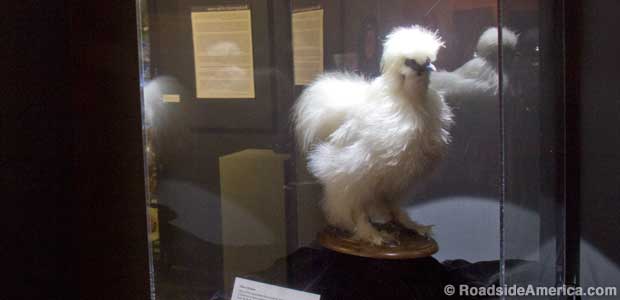
Silkie Chicken, ancient Chinese breeding.
Center for PostNatural History
Pittsburgh, Pennsylvania
"PostNatural," announces a recorded voice as you enter the Center for PostNatural History, "the living things that have been intentionally altered by human beings. Farm animals, pets, crops, flowers, laboratory organisms...."
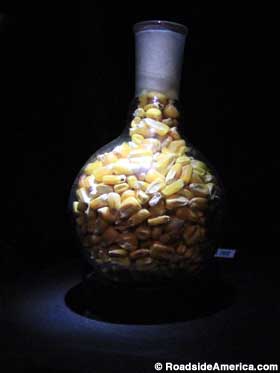
Genetically modified corn.
Although it sounds like a setup for a disheartening sci-fi future, the Center is here now: the creation of Richard Pell, a professor at Carnegie Mellon University. Pell is not a scientist; he teaches art. But he wondered why scientists didn't have a museum for creatures outside natural evolution. So he built one himself. To make it easy to maintain and operate, he lives upstairs.
"We have astonishing things, but they're all true," said Pell of his collection. "You don't need sci-fi to exaggerate it."
Some of the things in the Center's collection include GloFish, which are home aquarium pets gene-spliced with bioluminescent jellyfish and coral. There's a fluffy Silkie Chicken, bred in China centuries ago simply because people liked the way it looked. HeLa cells float in a Petri dish under purple light, harvested from a woman who died in 1951; her immortal cancerous cells are a backbone of the experimental drug industry. A flask of Sea Monkeys shows how selective breeding turned ordinary brine shrimp into creatures that could survive for years on toy store shelves. "It was intended to be the most benign exhibit," said Pell.
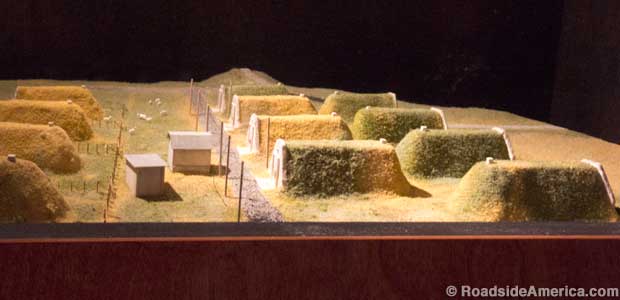
Model of former ammunition bunkers used to house Biosteel Goats.
Pell's artistic talents are everywhere in the Center, which is similar to the Museum of Jurassic Technology in its use of dark spaces and targeted lighting. "I wanted a sense of drama and wonder," said Pell. Visitors enter the self-guided tour under a taxidermied genetically altered salmon (engineered to grow 66 percent faster than normal fish) and walk among the darkened displays soothed by sonic washes and soft jungle sounds.
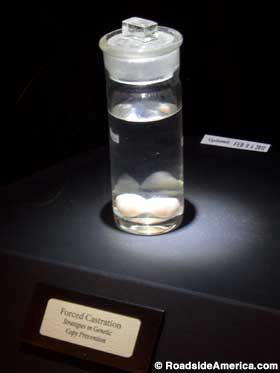
Testicles from a neutered cat.
One wall has an enlarged x-ray in 3-D (glasses are provided) of transgenic mice: one modified to have too many ribs, one to have none at all. A lonely pair of testicles from a neutered cat sit in a jar of preservative; pick up a telephone handset and a voice tells you how eugenics is used to eliminate unwanted populations.
Pell was blocked from acquiring even a photo of the secret U.S. military BioSteel goats, genetically altered to produce a milk chemical that strengthens body armor -- so he built a miniature diorama of the eerie decommissioned Air Force base where the goats live in old ammo bunkers. Monsanto refused to provide a sample of its RoundUp Ready transgenic corn -- so Pell grew his own by planting kernels from animal food and seeing which plants survived Monsanto's pesticide.
At the back of the Center, an entire gallery showcases the trash left behind by government agents who in 2004 raided the home of another college professor, convinced that his GM agriculture project must be bioterrorism. The debris on display includes a discarded HazMat suit, dozens of Gatorade bottles, a cigar that was ground into the carpet, and 17 boxes of pizza.
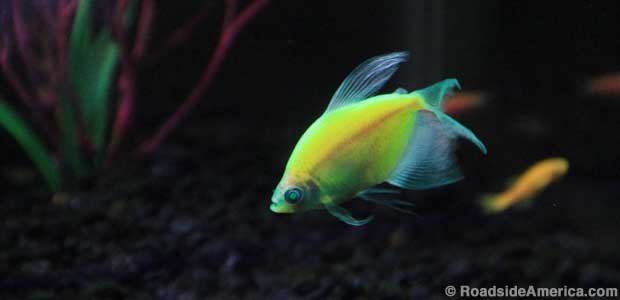
Fish bred for luminous coloration.
Pell has tried to make the Center impartial -- more of an artful look at freakish life-forms than a front for Monsanto or a platform to condemn Frankenfoods. "We get people who try to figure out if it's for or against," he said. "That's where we want to be, because then you're left to figure it out on your own."





